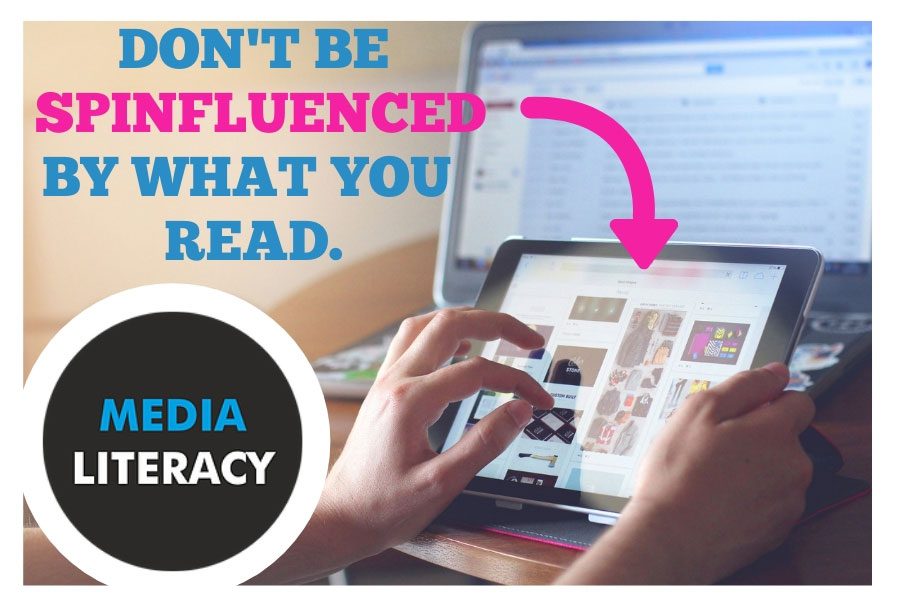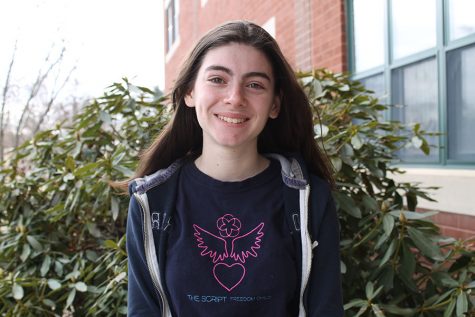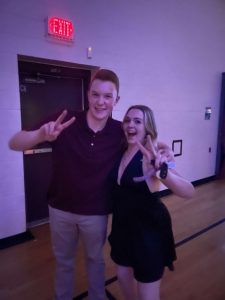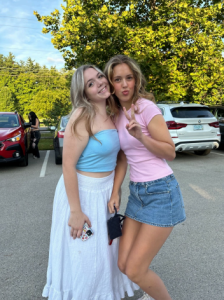Before you hit share
The Canva Poster, created by Christine Heaton, advertises the idea of media literacy. Media literacy, or the ability to discern the quality, bias, and authenticity of sources consumers view, create, and share, is becoming even more relevant as access to the internet and social media increases. “The biases become like super viruses. You can try to stop it, but it’s going to find a way around it,” said Heaton.
October 2, 2018
Today, thanks to the increase in access to a continuous stream of digital updates, false information can be widely shared with a ripple-like effect. All it takes is one click to send falsified news or events into the void of the internet, potentially sparking mass confusion and chaos. In order to become the best possible citizens and to combat the spread of newly-dubbed ‘fake news,’ students need to become media literate.
Misinformation and Media Literacy: The Basics
According to the Center for Media Literacy, one of most prominent educational centers in the field of media education, the term media literacy is officially defined as “a 21st century approach to education. It provides a framework to access, analyze, evaluate, create and participate with messages in a variety of forms — from print to video to the Internet. Media literacy builds an understanding of the role of media in society as well as essential skills of inquiry and self-expression necessary for citizens of a democracy.” In short, media literacy is a student’s pocket guide to the Internet. It is a priceless set of skills that encourages students to be constantly vigilant and question the authenticity/biases of the sources they view and share.
In today’s world, people are constantly assailed by information. Such facts and breaking news lambaste individuals in the form of push notifications from Snapchat, Instagram, Twitter, and other social media platforms, or news sources. Although the connectivity and awareness that the internet age has brought with it can be positive, it also creates more vulnerability to lies. “The digital revolution might bring the promise of enlightenment, but in its pathological lack of accountability might just as easily spread a virus of confusion and disinformation,” said Howard Schneider, the founder of the Stony Brook University’s school of journalism, in an interview with the Columbia Journalism Review.
People may not go looking for fake news. However, it is easily found on every social media account’s dashboard or feed. According to an NPR interview with media literacy advocate, Craig Silverman, many of the infamous false or misleading stories shared during the 2016 election were created by people looking to make money off site traffic. The information was then distributed and believed by gullible citizens who did not fact check their sources. “It’s chilling to think about how easy it is for anyone to disseminate false information and fast,” said Lauren Crossley, a career adventure-travel journalist and freelance writer.
The Psychology of Fake News
The internet is brimming with fake reports, but, what those spreading and receiving false information may or may not know is that it is all a psychological game.
Although the psychology of excess misinformation is not an exact science, it is clear that psychology and the effects of fake news go hand and hand. People are inclined to agree with information that aligns with their pre-existing values. In fact, the brain can alter the perception of one’s world to meet an incessant need to match the morals and opinions which developed during childhood. “[O]ne could say the brain is hardwired to accept, reject, misremember or distort information based on whether it is viewed as accepting of or threatening to existing beliefs” said Mark Whitmore, PhD, in an article by the American Psychological Association (APA).
For this very reason, media users are more likely to say fake news they agree with is real, while rejecting fake information with which they disagree. That psychological principle can provide insight into some of the reasoning behind extreme political polarization, at least as it pertains to falsified news.
Humans, by nature, are attracted to sensationalism. According to a study performed by Deryn Strange and Victoria Z. Lawson, News as (hazardous) entertainment: Exaggerated reporting leads to more memory distortion for news stories, people are more likely to remember the extremist details than a more simple story. “We found that despite being trusted less, more extreme reports were more likely to lead to memory distortion. Further, a warning had no impact on the degree to which memory was distorted or on perceptions of trustworthiness; thus, it is not clear how best to protect news consumers against the negative effects of exaggerated reporting on memory for current events,” said researchers Strange and Lawson in their study published by the APA.
Strange and Lawson’s study aligns with the idea that the brain is more likely to encode sensationalized information. In fact, one reason the brain better remembers facts if a weird story is made up about them, is because of that same idea. Extremes often make it into memory.
The Ripple Effect and Students
The current generation of students, coincidentally dubbed the iGeneration, is on the forefront of media literacy. With constant access to all sorts of information, students cannot solely rely on computer algorithms to keep them safe from misinformation. In fact, students could be participating in the race to share, like, and sensationalize most events that cross their screens.
Media literacy increases in significance because of the exponentially larger access to information at younger ages. “You have a whole new demographic of younger and younger people who are coming to their own ideas on things, which is wonderful, but are they recognizing their own biases as they come to those ideas?” said Christine Heaton, head librarian at Hollis Brookline High School. Today’s students are that demographic. They are the ones who are, for the first time ever, growing up surrounded not only by the influence of their parents on their views, but the influence of the entire world through news.
Statistically, elderly conservatives are the most likely victims for fake information distribution.This group is very significant in elections, and can be the difference between defeat and victory for a candidate. According to a study performed at Dartmouth College, one in every four Americans visited fake news websites within the key one month-window before the election. But six in every ten fake news website visits were older conservatives. While students may not be the most prominent users of false media web pages or posts, the outcome of elections and consequential policies will affect youth, students, and the iGeneration the most in the long run.
Beyond elections and the lawmaking of the future, knowing how to separate fact from fiction is key. While scrolling through the explore page on Instagram, students may come across fake posts that take something real and twist the context. While posts like those have the most resounding effect at the moment, the controlling fake news for the future’s sake is more important. “It’s not important for what’s going on right now, it’s important for what’s going to happen,” said Heaton. Fake news has a wider reach than just the made-up stories on Instagram. It can change the future: how well freedom of press is protected, who wins the next election, and other astronomical events. False information creates a ripple effect in the present, changing the future.
For years, teachers have been badgering students about the use of unvetted sources (like Wikipedia) with good reason. It is the media consumer’s job to keep themselves safe from the cycle of falsehood, as Lin Illingworth, an English teacher of over 30 years, suggested. Now, it may not seem like that could not matter outside of school projects, but being a properly-informed citizen is how students can truly help influence the world, regardless of age, education level, or anything else. The key is to stay correctly informed.
“With how quickly and uncontrollably the internet has grown, and given our irresponsible, voracious appetite for sensationalism, I don’t think any truth and reconciliation commission will ever be able to squash the fake news organism. Which is why it’s all the more important for citizens—and especially emboldened students!—to have a vested interest in safeguarding the truth, even if it doesn’t seem like it’s directly impacting their lives now. That passivity will eventually come back to haunt you, whether it’s the rising seas and scorched earth or your children’s marred education,” said Crossley as a plea to the next generation.
Students Making a Change
So, how can students break themselves and the community of the “24-hour spin cycle”, as Illingworth put it, of potentially falsified or worthless information?
Students can start by questioning. “It’s just like you want to know what the ingredients are, what you are putting into your body. You should be aware of what we are putting into our minds and our hearts through media, how we are being manipulated, how we are being sold,” said Illingworth. In order to become media-literate, the public has to stop believing everything they see, and has to start being critical of their information.
Warning: pondering such critical thinking questions may lead to answers that don’t fit with the natural way the brain works; students may be appalled by some the ingredients. But, it is that thought process that improves the brain’s interpretation of the world and society in general. Not to mention, questioning gives the trolls who produce the false information nothing to work with. “[W]hen people are spreading falsehoods like that they are just looking for attention. And so, if we keep on retweeting, if we keep on sharing that with all these people, then they are going to get exactly what they are looking for. They are not going to think there’s any issue with what they’re doing. So I think that honestly, if you stopped giving attention to the media outlets that are spreading those falsehoods, they are not going to have anything to bounce back off of and continue,” said Nicole Plummer ‘19, former student of Illingworth’s AP Language and Composition class, which included a unit on media literacy.
To evaluate credibility, start by asking ‘who?’ Who published the story? Who wrote the story? Have I heard of this person before? Who did they interview, is that person credible in their field? By questioning the author, students can immediately discern the quality of the source. Often times, the best quality sources are from authors who are prestigiously recognized in their field, were at or in the event, and have a clean journalistic record. After doing so, the sources can be brought into question. The sources must be as credible, or more credible than the author, considering the author is reporting on what the source says.
Next, ask ‘where’? Where did this article come from? What media platform was it found on? If I search the name or content, where else does it pop up? What does the URL or domain indicate? Figuring out where a source came from can be a good indicator of the quality. If it came from a high quality, relatively unbiased news source, then it is likely share-worthy. If not, alarm bells should go off in students’ heads. Being unable to find where an article came from, or a legitimate source to support it, is a decent sign that the information is not valid.
Finally, and most importantly ask ‘why’ and ‘what’. Why did the author write this? What does the author want me to think? What is the bias? What is the context, why was it excluded/included? What are the supporting facts, are those valid? Most stories can be biased in some capacity, however, the real question is does it interfere with the story? While bias can be subjective to an extent, a lack of context is almost a sure sign of exaggeration, or false information. Without context, a story is obsolete.
By educating themselves, students can help call out fake news, benefiting both themselves and the community. Beyond simply asking themselves questions, students can check out Heaton’s media literacy campaign of the Hollis Brookline High School Library Facebook page and keep and eye out in the hallways for media literacy signs.














